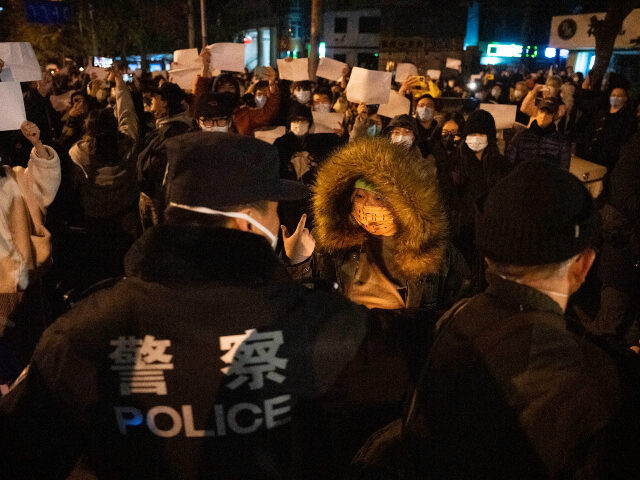Thousands of people in the central Chinese metropolis of Wuhan, the place where the ongoing Coronavirus pandemic began, took the streets of the city on Wednesday to protest a dramatic reduction in health care benefits the Communist Party has proposed in light of its titanic expenditures throughout the past three years.
The northern city of Dalian experienced another protest on Wednesday, forcing police to corral the crowd and resulting in clashes between law enforcement officers and civilians. Fewer videos and testimony about the Dalian protest are available at press time than the Wuhan event, though multiple media sources verified that it happened.
Videos uploaded to the internet – and likely swiftly deleted off of Chinese regime-controlled social media – out of Wuhan show a massive crowd of thousands of mostly elderly protesters, those most severely affected by the healthcare benefit cuts.
The protest in the central city is the second of its kind this month, following a smaller manifestation on February 8 in which throngs of seniors sang the communist anthem “The Internationale” while police attempted to disperse the assembly. The growing numbers of protests led by elderly Chinese have been dubbed the “white hair movement” and represent part of a rising tide of public dissent that greatly escalated last year in response to the Communist Party’s brutal lockdown and quarantine scheme, allegedly policies meant to stop the spread of Chinese coronavirus.
Those protests peaked in late November, when the streets of some of China’s biggest cities – Beijing, Shanghai, Chengdu, and Guangzhou, among others – flooded with angry protesters demanding dictator Xi Jinping cease forcing people into unsanitary quarantine camps, trapping them in house arrest without food, and treating them as criminals if suspected of needing cold medicine.
Unlike the protests this week, however, the participants in the anti-lockdown protest wave were largely young people, disproportionately women, many of whom disappeared unceremoniously following the protests. The Communist Party conceded to “optimizing” its lockdown protocol, promising an end to “large-scale” lockdowns and allowing coronavirus patients with mild symptoms to avoid quarantine prisons, but reports out of Wuhan on Wednesday suggested the regime is still using lockdown protocol to prevent suspected would-be protesters from leaving their homes.
The largest congregation in Wuhan, as indicated by social media videos shared from the scene and verified by multiple media outlets, was Zhongshan Park. The videos show a line of police attempting to surround the largely elderly protesters but facing physical pushback as the seniors shoved and otherwise attacked law enforcement officers.
“In one clip, an elderly man is seen lying on the ground with his head and legs propped up while people boo and shout at the police,” Radio Free Asia (RFA) documented.
Locals speaking to RFA confirmed that the videos circulating online depicted scenes from a protest in Wuhan on Wednesday. The Agence France-Presse (AFP) and Taiwan’s Liberty Times similarly verified the videos, the latter describing the protest as the latest episode of what Chinese people are increasingly calling the “white hair movement” – protests led by Chinese seniors.
Zhang Qiang, a resident of Wuhan, told RFA that police had forced many residents suspected of having an interest in joining the protests into unofficial house arrest, banning them from leaving their homes. Zhang referred to the wing of police dedicated to trapping people at home as “stability maintenance.”
“I have been roped in, too,” Zhang lamented.
A similar, smaller protest by the elderly of Wuhan occurred on February 8, which also featured a crowd rendition of “The Internationale,” but less violent exchanges with officers. Police managed to subdue the protest and the local government did not reform any of its healthcare policies, resulting in Wednesday’s assembly. As participants threatened to organize on February 15 again, the government attempted to prepare for the protests by organizing “grandparent” community events to distract the city’s seniors, according to RFA.
2月8号白天,武汉上万名退休老人上街抗议武汉医保改革。
在现场高唱国际歌。 pic.twitter.com/xN3C7eA86G— 李老师不是你老师 (@whyyoutouzhele) February 8, 2023
Videos shared by dissidents online and verified by Voice of America from Dalian show that a confrontational crowd of older residents also congregated there, outraged by a disproportionate police presence in response to their decision to protest. The residents also targeted not just the government generally but shouted the name of Mayor Chen Shaowang, demanding a response to their woes.
“老百姓不容易啊,‘三年自然灾害’我们没死,文化大革命我们没死,这次疫情我们没死。现在大连政府怎么派这么多警察来对付老百姓?”一位大连市民问。星期三中国医保改革引发的抗议延烧至这座北方城市。同日,武汉民众继续上街。退休人员万先生说,中山公园门口聚集了十多万民众,现场警察也在十万左右。 pic.twitter.com/PZo09QhEzG
— 美国之音中文网 (@VOAChinese) February 16, 2023
网友补充
之前大连西岗区人民广场 政府大楼前
民众呼喊大连市长的名字 pic.twitter.com/vQUISPk5uA— 李老师不是你老师 (@whyyoutouzhele) February 15, 2023
The Chinese Communist Party recently announced health insurance “reforms” that significantly reduce citizens’ access to health care. In Wuhan, the anti-communist newspaper Epoch Times reported, “the Chinese regime reduced the health benefit payments by more than two-thirds.” Beijing insisted that the cuts were necessary after the past three years of spending on extravagant, alleged anti-pandemic projects, such as quarantine camps, makeshift hospitals, mandatory coronavirus test kits, and other items, leaving local governments to budget their resources with little help from above.
A Wuhan resident identified as Gao told the Epoch Times that the city is home to about 2 million retirees disproportionately hurt by the new policies.
“He said that among the protesters, there were also people protesting the cut in funeral expense claims, that went from 70,000 yuan (about $10,310) to 30,000 yuan (about $4,420) per person. Just last year, it was further reduced to 19,000 yuan (about $2,800),” the newspaper detailed.
Health care is just one of a long list of topics outraging the average Chinese citizen in the past year, leading to widespread protests across the country that have yet to abate after escalating in the past year. The human rights organization Freedom House published a report on Tuesday documenting over 1,000 acts of protest in China between June and December 2022, many driven by the ongoing, sudden lockdown policies that trapped millions of Chinese people in their homes with minimal food supplies and no basic medicines. Freedom House estimated that at least 23,000 people participated in protests against the government during the time frame analyzed.

COMMENTS
Please let us know if you're having issues with commenting.